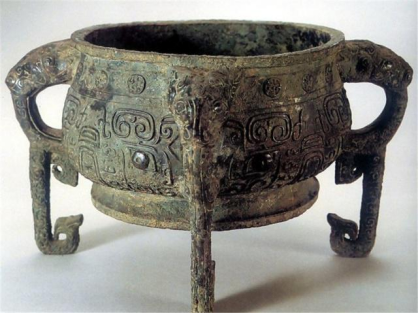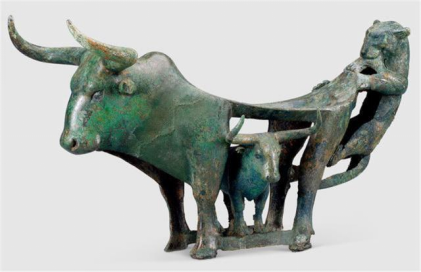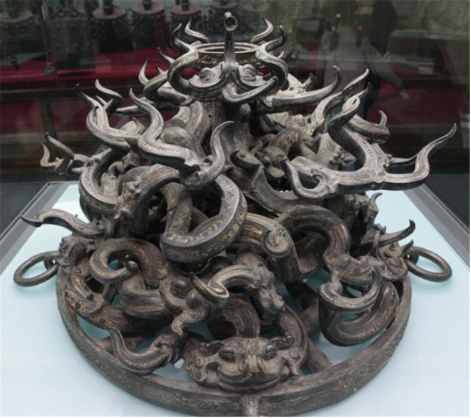Early Yunnan Bronze Culture
The bronze culture in Yunnan has been discovered earlier in the Spring and Autumn Period, in Jianchuan Aofeng Mountain, Xiangyun Dabona, Chuxiong Wanjiaba, Jinning Shizhai Mountain, Jiangchuan Lijia Mountain, Anning Taiji Mountain, Chenggong Tianzi Temple and other places. are distributed. The ore used for copper smelting in ancient Yunnan was malachite. This green and bright mineral is named for its resemblance to the color of peacock feathers. Malachite has a large copper content and is easier to smelt. As long as the ore is heated to 1000 ° C, copper can be smelted. In terms of casting methods, there are mainly two methods of casting bronze ware in Yunnan: stone casting and lost wax casting. The so-called stone fan is to first make a stone into a mold, and then pour the copper liquid into the stone fan, and after cooling, the required bronze ware is obtained.

The lost wax process is more complicated than the stone fan process. First, the clay is kneaded into the shape of the utensil to be cast, which is a "mud tire"; then the mud tire is replaced with beeswax to become a wax tire; then the wax tire is sealed with sealing mud, and heated. The wax tire is melted and the wax juice is poured out, and then the copper liquid is poured into the hollow tire mold, and the whole casting process is completed after it cools down. Among the nearly 10,000 bronze ware unearthed in various places, the bronze coffin unearthed in Dabo Na of Xiangyun, the bronze drum unearthed from Wanjiaba in Chuxiong, and the bronze ware cattle and tiger case in Dianchi Lake area are the most representative. Now, they are described respectively: In Dabo, Xiangyun County in 1964 That found a large wooden coffin and copper coffin. The copper coffin is composed of two wall panels, one bottom panel, one head and one tail panel. The coffin lid is made of two copper plates combined into a herringbone roof shape, and the outer coffin is protected by a wooden coffin. There are more than 90 bronze wares buried in the burial, and the more special one is two bronze horse figurines, one of which is ridden.

In addition, there are production tools such as hoes, axes, and chisels, as well as models of textile tools, houses and six animals. The copper coffin unearthed in Dabona weighs 275 kilograms. Except for the bottom plate, the remaining six copper plates are all cast with delicate patterns. Without high-quality casting models, simultaneous operation of several crucibles and skilled casting skills, it is unimaginable to cast such a huge and complex copper plate at one time. Among the ancient tombs of Wanjiaba in Chuxiong excavated in 1975 and 1976, a total of 79 tombs were cleared, and many bronze wares were unearthed. one. The Wanjiaba bronze drum is characterized by its simple and heavy shape. The drum surface is particularly small, and the drum body is clearly divided into three sections: chest (carcass), waist and feet. The chest is very bulging. If a midline is drawn at the level of the chest, its maximum diameter is below the midline, and the waist is very tucked.

The sun pattern on the drum surface is in the forming stage, some are like a round cake, and some are round cake with a few rays of light added, and there is no halo. There are only thunder patterns and vertical lines on the waist of the drum. Strangely, the inner wall of the drum is also decorated with patterns, which seems to be related to the fact that the bronze drum was originally placed upside down. Wanjiaba bronze drums were popular from the middle of the Spring and Autumn Period to the early Warring States Period in the 7th century BC. From the absolute age and the primitiveness of the shape and pattern, it can be seen that the Wanjiaba bronze drum is the earliest bronze drum.
So far, only 17 Wanjiaba-type bronze drums have been found in Yunnan. They are distributed in the west of Dianchi Lake in Yunnan to Tengchong, but mainly concentrated between Dianchi Lake and Erhai Lake.
The bronze drum related to the Wanjiaba type is the Shizhaishan type. The shape of the Shizhaishan bronze drum is basically the same as that of the Wanjiaba bronze drum. The difference is that the production is more delicate, the drum surface is enlarged, the maximum diameter of the chest is above the midline, and the foot is also increased. The realistic figures and animal patterns very prominent.
Specializing in the production and processing of various types of Chinese bronze tripods, it can be customized for various types of tripods, four-legged copper tripods, imitation bronze tripods, etc. Wholesale orders are welcome.









